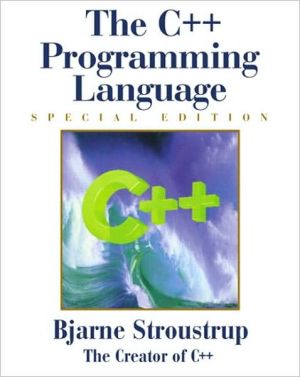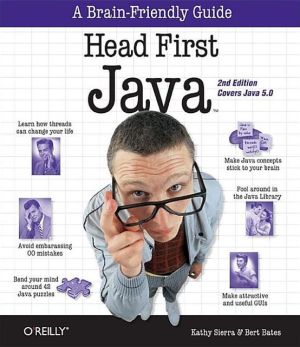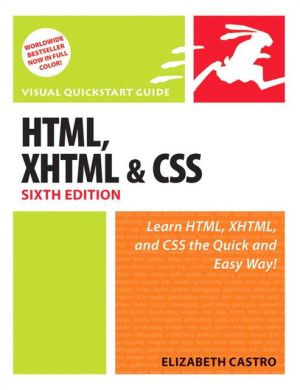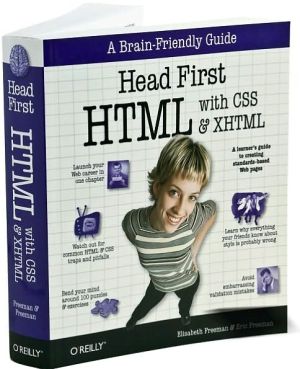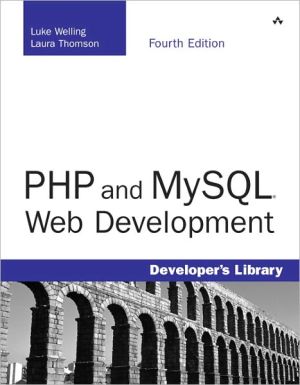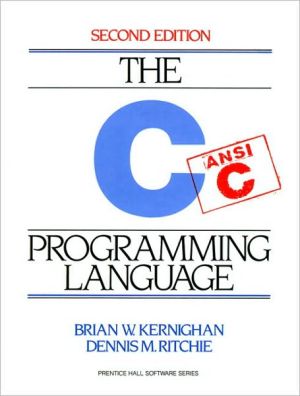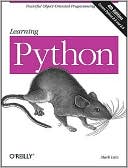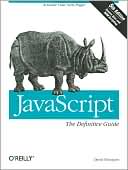The C++ Programming Language: Special Edition
More than three-quarters of a million programmers have benefited from this book in all of its editions\ Written by Bjarne Stroustrup, the creator of C++, this is the world's most trusted and widely read book on C++.\ For this special hardcover edition, two new appendixes on locales and standard library exception safety (also available at www.research.att.com/~bs/) have been added. The result is complete, authoritative coverage of the C++ language, its standard library, and key design...
Search in google:
More than three-quarters of a million programmers have benefited from this book in all of its editionsWritten by Bjarne Stroustrup, the creator of C++, this is the world's most trusted and widely read book on C++.For this special hardcover edition, two new appendixes on locales and standard library exception safety (also available at www.research.att.com/~bs/) have been added. The result is complete, authoritative coverage of the C++ language, its standard library, and key design techniques. Based on the ANSI/ISO C++ standard, The C++ Programming Language provides current and comprehensive coverage of all C++ language features and standard library components.For example: abstract classes as interfaces class hierarchies for object-oriented programming templates as the basis for type-safe generic software exceptions for regular error handling namespaces for modularity in large-scale software run-time type identification for loosely coupled systems the C subset of C++ for C compatibility and system-level work standard containers and algorithms standard strings, I/O streams, and numerics C compatibility, internationalization, and exception safety Bjarne Stroustrup makes C++ even more accessible to those new to the language, while adding advanced information and techniques that even expert C++ programmers will find invaluable. Victor J. Duvanenko There is absolutely no doubt that Bjarne Stroustrup's The C++ Programming Language, Third Edition is a must-have book. If you are programming in C++, you will refer to it every other day. If you are learning C++, you need to dedicate time to read one chapter a week. This third edition is much more approachable than its predecessors and has gems of insight sprinkled throughout. Furthermore, it includes a good introduction to Standard Template Libraries (STL) and describes the various new C++ features...the book is very well done, and we thank Bjarne Stroustrup for his tireless effort for over a decade to improve the lives of programmers. Dr. Dobb's Electronic Review of Computer Books
Programming is understanding.\ — Kristen Nygaard\ I find using C++ more enjoyable than ever. C++'s support for design and programming has improved dramatically over the years, and lots of new helpful techniques have been developed for its use. However, C++ is not just fun. Ordinary practical programmers have achieved significant improvements in productivity, maintainability, flexibility, and quality in projects of just about any kind and scale. By now, C++ has fulfilled most of the hopes I originally had for it, and also succeeded at tasks I hadn't even dreamt of.\ This book introduces standard C++* and the key programming and design techniques supported by C++. Standard C++ is a far more powerful and polished language than the version of C++ introduced by the first edition of this book. New language features such as name spaces, exceptions, templates, and run-time type identification allow many techniques to be applied more directly than was possible before, and the standard library allows the programmer to start from a much higher level than the bare language.\ About a third of the information in the second edition of this book came from the first. This third edition is the result of a rewrite of even larger magnitude. It offers something to even the most experienced C++ programmer; at the same time, this book is easier for the novice to approach that its predecessors were. The explosion of C++ use and the massive amount of experience accumulated as a result makes this possible.\ The definition of an extensive standard library makes a difference to the way C++ concepts can be presented. As before, this book presents C++ independently of any particular implementation, and as before, the tutorial chapters present language constructs and concepts in a "bottom up" order so that a construct is used only after it has been defined. However, it is much easier to use a well-designed library than it is to understand the details of its implementation. Therefore the standard library can be used to provide realistic and interesting examples well before a reader can be assumed to understand its inner workings. the standard library itself is also a fertile source of programming examples and design techniques.\ This book presents every major C++ language feature and the standard library. It is organized around language and library facilities. However, features are presented in the context of their use. That is, the focus is on the language as the tool for design and programming rather than on the language in itself. This book demonstrates key techniques that make C++ effective and teaches the fundamental concepts necessary for mastery. Except where illustrating technicalities, examples are taken from the domain of systems software. A companion, The Annotated C++ Language Standard, presents the complete language definition together with annotations to make it more comprehensible.\ The primary aim of this book is to help the reader understand how the facilities offered by C++ support key programming techniques. The aim is to take the reader far beyond the point where he or she gets code running primarily by copying examples and emulation programming styles from other languages. Only a good understanding of the ideas behind the language facilities leads to mastery. Supplemented by implementation documentation, the information provided is sufficient for completing significant real-world projects. The hope is that this book will help the reader gain new insights and become a better programmer and designer.\ Acknowledgments\ In addition to the people mentioned in the acknowledgment section of the first and second editions, I would like to thank Matt Austern, Hans Boehm, Don Caldwell, Lawrence Crowl, Alan Feuer, Andrew Forrest, Tim Griffin, Peter Juhl, Brian Kernighan, Andrew Koenig, Mike Mowbray, Rob Murray, Lee Nackman, Joseph Newcomer, Alex Stepanov, David Vandevoorde, Peter Weinberger, and Chris Van Wyk for commenting on draft chapters of this third edition.\ I would also like to thank the volunteers on the C++ standards committees who did an immense amount of constructive work to make C++ what it is today. It is slightly unfair to single out individuals, but it would be even more unfair not to mention anyone, so I'd like to especially mention Mike Ball, Dag Brueck, Sean Corfield, Ted Goldstein, Kim Knutilla, Andrew Koenig, Josee Lajoie, Dmitry Lenkov, Nathan Myers, Martin O'Riordan, Tom Plum, Jonathan Shopiro, John Spicer, Jerry Schwarz, Alex Stepanov, and Mike Vilot, as people who each directly cooperated with me over some part of C++ and its standard library.\ After the initial printing of this book, many dozens of people have mailed me corrections and suggestions for improvements. I have been able to accommodate many of their suggestions within the framework of the book so that later printings benefitted significantly. Translators of this book into many languages have also provided many clarifications. In response to requests from readers, I have added appendices D and E. Let me take this opportunity to thank a few of those who helped: Dave Abrahams, Matt Austern, Jan Bielawski, Janina Mincer Daszkiewicz, Andrew Koenig, Dietmar Kuehl, Nicolai Josuttis, Nathan Myers, Paul E. Sevinc, Andy Tenne-Sens, Shoichi Uchida, Ping-Fai (Mike) Yang, and Dennis Yelle.\ Bjarne Stroustrup Murray Hill, New Jersey\ 0201700735P04062001
PrefacePreface to Second EditionPreface to First Edition1Notes to the Reader32A Tour of C++213A Tour of the Standard Library454Types and Declarations695Pointers, Arrays, and Structures876Expressions and Statements1077Functions1438Namespaces and Exceptions1659Source Files and Programs19710Classes22311Operator Overloading26112Derived Classes30113Templates32714Exception Handling35515Class Hierarchies38916Library Organization and Containers42917Standard Containers46118Algorithms and Function Objects50719Iterators and Allocators54920Strings57921Streams60522Numerics65723Development and Design69124Design and Programming72325Roles of Cases765App. AThe C++ Grammar793App. BCompatibility815App. CTechnicalities827Index869
\ Victor J. DuvanenkoThere is absolutely no doubt that Bjarne Stroustrup's The C++ Programming Language, Third Edition is a must-have book. If you are programming in C++, you will refer to it every other day. If you are learning C++, you need to dedicate time to read one chapter a week. This third edition is much more approachable than its predecessors and has gems of insight sprinkled throughout. Furthermore, it includes a good introduction to Standard Template Libraries (STL) and describes the various new C++ features...the book is very well done, and we thank Bjarne Stroustrup for his tireless effort for over a decade to improve the lives of programmers. \ Dr. Dobb's Electronic Review of Computer Books\ \ \ \ \ BooknewsStroustrup, creator of C++, covers standard C++ and the key programming and design techniques supported by C++, including every major language feature and the standard library. Suitable for those new to the language while adding advanced information and techniques for the more advanced programmers, this hardcover edition includes two new appendixes on locales and standard library exception safety. Annotation c. Book News, Inc., Portland, OR (booknews.com)\ \ \ Victor J. DuvanenkoThe Gospel According to Bjarne\ Bjarne Stroustrup's The C++ Programming Language, Third Edition (Addison-Wesley, 1997) has been available for several months. This work, by the creator of C++, is the definitive treatment of the subject and has been since its first edition in 1987. I must confess that I did not care for the first edition. I had expected a tutorial approach as elegant as the classic K&R white book. But then, K&R was about C, a programming language that supported a familiar programming model. The C++ programming model was new to most of us ten years ago, and Stroustrup's first edition was daunting, to say the least. Looking at it now, I find it far less so and much easier to read.\ Comparing the first and third editions of The C++ Programming Language provides insight into how the C++ language has grown and changed in the past decade. The third edition has almost three times the number of pages and a slightly different organization. Whereas the first edition included a 67-page language reference manual at the end, the third edition includes only a language grammar section to represent formal language definition. This is appropriate. The ANSI/ISO Standard document, which is now the formal language and library definition, is itself about 750 pages long. Stroustrup plans to publish The Annotated C++ Language Standard (coauthored by Andrew Koenig, the ANSI C++ committee's Project Editor) sometime this year.\ The third edition takes a tutorial approach with many of Stroustrup's personal programming philosophies. The author's explanations of how he uses language features provide examples for learning the behavior of those features. He also explains code idioms that some programmers routinely use but that he finds inappropriate.\ As much as possible, the third edition reflects Standard C++. When small language features are found to be missing, particularly new ones, Stroustrup pledges to add them to a future printing.\ The book includes many code examples. There is no diskette or CD-ROM, because Stroustrup avoids a teaching approach wherein readers compile and run examples. His examples are mostly code fragments that demonstrate the points he makes and the issues he addresses. The code fragments are readable, meaningful, and neither frivolous nor cute, and since you do not compile them, you need not worry that your compiler does not fully support Standard C++. There are four parts to the body of the book: "Part I: Basic Facilities;" "Part II: Abstract Mechanisms;" "Part III: The Standard Library;" and "Part IV: Design Using C++." Even if you are already a seasoned C++ programmer, Part IV, which is a rewrite of several chapters from the second edition, is worth the price of the book. It describes Stroustrup's philosophies on the design and development cycle of a software project involving C++. In his words, Part IV aims "to bridge the gap between would-be language-independent design and programming that is myopically focused on details."\ The three appendixes are: "A: The C++ Grammar;" "B: Compatibility;" and "C: Technicalities." Appendix B discusses the differences between C and C++ and explains how the languages have become more compatible over time. Some of this convergence results from changes being made to the C specification (double-slash comments and no implicit int, for example). The appendix also discusses the issues related to porting C++ code from older C++ implementations, advising that, where possible, you should use the latest implementation of a compiler so that newer features are available to you.\ Appendix C is about technical details that a programmer faces that are not necessarily language issues. I particularly like the discussion on the problems associated with traditional multidimensioned arrays as compared to using STL containers to achieve the same result without the headaches.\ This book is an essential addition to a C++ programmer's library. It is not for dummies, and it wouldn't be my first choice for an entry-level, self-help tutorial on C++ for beginning programmers. It is, however, an excellent textbook for programmers who are self-motivated and students who study under the watchful care of a skilled instructor. As an experienced C++ programmer, I find the book useful as a reference to language usage and behavior. The author invented the language and then stayed close to the standardization and innovation process for the duration, always maintaining a careful vigilance over the evolution of his brainchild. Consequently, this book serves, for those who do not care to pore over the ANSI/ISO document (or the promised annotated version), as the authority on the Standard C++ language, how it works, and how you should use it.--Dr. Dobb's Electronic Review of Computer Books\ \ \
